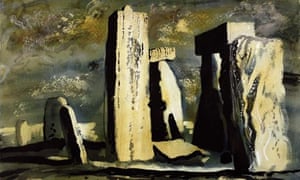Recent Reading

I've
been progressing at a leisurely pace through Alexandra Harris'
Romantic Moderns (2013). Unlike many of the other academic
studies I have proposed to read which much of the time weave some
wilfully obscure, theoretical line of reasoning, flexing their
scholarly credentials in the process, Harris' thesis seems relatively
simple by comparison, perhaps even academically naïve. However, what
it lacks in depth it makes up for enormously in scope. Simply put, I
have learnt a huge amount since I started reading it, savouring the
rich variety and nuance of each chapter. It imbues its subjects with
life and colour, written with documentary clarity.
'Stonehenge, Wiltshire' by John Piper (1981)
Indeed,
each chapter is like a little world in itself and much of my
satisfaction emanates from how Harris disentangles the bundle of
colours, feelings and ideas which constitute my understanding of that
cultural milieu. Ranging across the Georgian and Victorian revivals
(the underlying ethics of abstract formalism against frivolous
ornamentation), the re-discovery of British watercolour painters like
Francis Towne and John Sell Cotman and their influence on
contemporary art, or the search for “authentic” British cuisine,
the revival of interest in village life and the new capacities for
access to the countryside aided by the Shell Guides. What Harris is
ultimately attempting to show in this study is how this revival of
“English culture” was informed and, in fact, led much of the time
by those who, a couple decades previously, been thoroughly
avant-garde in sensibility. Harris cites numerous instances of this
blurring between progressivism and tradition in the opening chapters
which, taken individually, fail to convince, but together demonstrate
the nuance and complexity of discourse between “old” and “new”
that characterised the cultural concerns of that time.
Another
book I have recently been reading from is Jed Esty's A Shrinking
Island (2003), which sees this discourse in terms of a cultural
shift for modernism he labels “the anthropological turn”. His use
of this term alongside the invocation of Raymond Williams' concept of
“metropolitan perception” has, for me, balanced out the
theoretical ambivalence of Romantic Moderns. Linking this
cultural turn to the decline of Britain as an imperial power, Esty
writes
The relativization of England as one culture among many in the face of imperial contraction seems to have entailed a relativization of literature as one aspect of culture; together these discursive events constitute the anthropological turn of later modernism in particular and English culture in general after 1930. (Esty, 2003: 8)
As
such, documenting the particular and the local became of greater
importance than the abstract universalism of the previous decades.
The final major works of two major modernists, Virginia Woolf's
Between the Acts (1941) and T.S. Eliot's Four Quartets
(1943), demonstrated this shift in cultural disposition away from
forward-looking abstraction to backwards-gazing vernacular. Away from
cosmopolitan fragmentation and towards the local and particular. It
is important to stress that another motivation for this documentary
impulse in the late 30s and 40s was the threat posed by the second
world war to the “national” way of life. This is apparent, for
instance, from the “Recording Britain” series of landscape
paintings commissioned at the time and now held by the V&A, and
the Neo-Romantic vision in the films of Powell and Pressburger. Esty
sees this project not as a nostalgic lamentation for an unrecoverable
past, but instead providing “the basis for both social and
aesthetic renewal” (Esty, 2003: 3).
'Buscot Park from the north east' by Felix Kelly (1944)
This morning I read Donald Bassett's article 'Felix Kelly, Herbert Read and Neo-romanticism' (2007). What drew me to this article was not so much the first name, who provides the main focus of the article, but the second; the art critic, poet, writer and philosopher Herbert Read (for whom Kelly provided illustrations for his novel The Green Child (1935)). I discovered Read from Peter Marshall's Demanding the Impossible: A History of Anarchism (1993), where his aesthetic philosophy is described:
Read, like Wilde, saw his anarchist philosophy flower directly from his aesthetic concerns. A life without art, he believed, would be a 'graceless and brutish existence'. Taking up Eric Gill's cry 'To hell with culture', he criticized the elitist culture of his day as 'dope, a worse dope than religion'. In its place, he wanted to develop a democratic culture which could best be achieved through the expansion of personal and social freedom. Read believed human beings to be naturally creative: 'If we follow this Natural Order in all the ways of our life, we shall not need to talk about culture. We shall have it without being conscious of it.' At the same time, the artist can only realize his full creative potential if he is free and art autonomous. There is therefore a vital and organic link between freedom and culture.(Marshall, 1993: 588-589)
Since
beginning this project, Read's name has popped up numerous times in
relation to the Neo-Romantic school of art of which he was a major
supporter. Having strong affinities myself with the arts and crafts
quietist anarchism of people like William Morris, Edward Carpenter
etc. I find it surprising that I have not already read any of Herbert
Read's work, something I intend to correct immediately. His vitalist,
anti-elitist view of culture combined with his love of the old
certainly chimes with my own but also with the outlook of John Cowper
Powys. This is something I wish to pursue in later posts.





Comments
Post a Comment